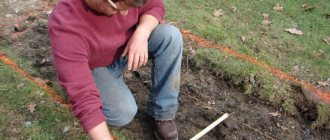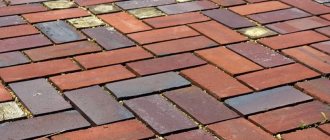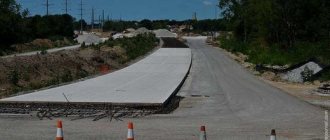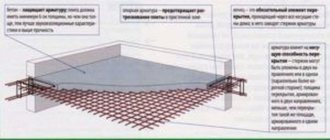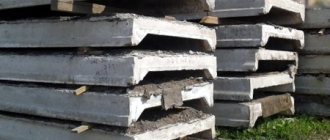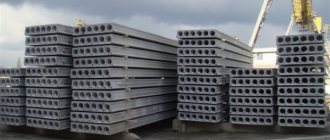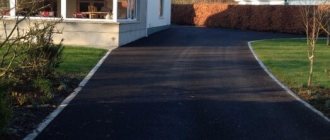Organizing a convenient road is important in construction of any scale. For the construction of access roads, the easiest way is to use reinforced concrete road slabs, the dimensions of which can be selected according to the conditions of use. We understand how reinforced concrete products are classified and how they are laid in certain cases.
Installation of road slabs Source demontazhnik.com.ua
Manufacturing, design and parameters
High-quality concrete products are manufactured in industrial conditions using the following technology:
- Preparation. The pouring mold is cleaned of concrete residues from the previous cycle. The inner surface of the metal mold is coated with lubricant. The lubricant layer reduces the adhesion of the concrete mixture and makes it easier to remove the finished product.
- Reinforcement. A frame (main and auxiliary reinforcement mesh) is installed in the mold. Caracas can be tensioned (assembled from pre-tensioned rods) or non-tensioned (made from wire or reinforcement). When the frame is formed, it is fixed to maintain the specified distances.
- Pouring concrete. At different enterprises, concrete is poured in two ways: on a stand (in small workshops) or on a conveyor line.
- Heat treatment. The prepared forms are placed in thermal chambers. Here the workpiece is treated with hot steam until the slabs gain 60% strength. The process takes 8-12 hours.
- Extraction. When the products have set, remove the fasteners. The slabs are removed, quality checked, and marked.
Metal molds for the production of reinforced concrete products Source aerodorstroy.ru
The characteristics of the slabs are influenced by the properties of the concrete mixtures used. To increase wear resistance and strength, mixtures with different water resistance and frost resistance are used. Reinforcement of different diameters, with different tensile strength values, and different grades of steel are also used. To form reinforced concrete products, predominantly corrugated reinforcement is chosen.
Concrete serves as a binding agent. The higher the grade of concrete, the stronger the structure, the better it will resist loads. Some types of slabs have a corrugated surface, which allows asphalt or other coating to stick on top. For ease of installation, the end sides of some plates are provided with hinges embedded in special recesses.
State standards require a basic classification according to parameters as follows:
- Products with dimensions 300x175 cm (length, width).
- Products with dimensions 350x275 cm
- For products with a length of 600 cm, the width varies: 175, 187, 350, 375 cm.
Mounting loops in reinforced concrete structures Source ubet39.ru
Intermediate dimensions are also possible. The finished product has the following parameters:
- The thickness of the road slab varies between 140-180 mm.
- The mass reaches 4-5 tons, part of it is reinforcement. For example, in a PDN-14 slab weighing 4105 kg, the concrete part accounts for 4032 kg, and the reinforcement accounts for approximately 73 kg. For the PDN-18 brand weighing 5284 kg, respectively, 5184 and approximately 100 kg.
General information
The weight of the road slab, as a rule, does not exceed 2.2 tons, and the thickness is approximately 200 mm. If you need to determine the permissible load that a reinforced concrete product can withstand, you need to know the grade of concrete from which it was made. The main advantage of the road slab is that it has excellent technical data. In addition, working with this product is convenient.
Such slabs can be dismantled if necessary, so they can be reused. However, it is important to know: when storing them, the permissible height of the stacked slabs should be no more than two meters, and a wooden beam should be made between the rows.
Classification
The performance characteristics of slab construction mat are described in GOST 21924.0-84 (Reinforced concrete slabs for urban road surfaces). Products can be conveniently divided into the following categories:
- PDP (flat road slab). A universal and therefore in demand product; designed for frosts down to – 50°C. Suitable for the construction of temporary and permanent roads, can be reused. The material can withstand an average load: 10-30 tons (depending on the brand of concrete mixture).
- PDN (stressful road). The product has expanded capabilities: it is not afraid of frosts down to -55°C, thanks to reinforced reinforcement it behaves well on soft soils, and copes with increased dynamic loads. Suitable for use in areas with harsh winters.
Dimensions of road reinforced concrete products Source amazonaws.com
See also: Catalog of companies that specialize in designing and performing landscape work of any complexity
- PAG (airfield smooth). The most durable and massive (from 5 tons) products. They are divided into two types: with the help of PAG-14 they build roads for heavy vehicles, the PAG-18 nomenclature is intended for runways. Corrugated products can withstand frosts of at least -35°C and loads of up to 75 tons.
The marking includes alphabetic and numerical parts. The letter markings of road slabs indicate the shape and method of use; the gradation looks like this:
- P (or 1P, 2P). Standard shaped products.
- PB or PBB. Products with one or two combined sides.
- PT. The products are trapezoidal with slight corrugation.
- PSH. Hexagonal options. They may have different proportions and methods of combination, as evidenced by the abbreviations PShP and PShD.
The first number indicates the method of using reinforced concrete products for the road surface (whether it will be permanent or temporary); One means permanent coverage, two means temporary. Lastly, the dimensions of concrete road slabs are indicated. For each product its own parameters are indicated (in decimeters, rounded to the nearest whole number).
The canvas is designed for use under high loads Source folksland.net
About the pros and cons of technology
The use of reinforced concrete products in road construction is beneficial for the following reasons:
- Relatively small budget required for laying road slabs; nice price/quality ratio.
- Quality. The slab material is manufactured in a factory and has strictly regulated performance characteristics.
- Long lasting results. A road or platform made of road slabs, built in accordance with the technology, will last 30-40 years.
- Simple technology with high performance. Ready-made concrete products are stacked using a truck crane or other crane equipment. The speed of installation does not affect the quality of the coating.
- High performance characteristics. The road surface is durable, wear-resistant, resistant to dynamic loads and weather factors. In Russian conditions, the resistance of the road surface to a wide temperature range (from -50 to +55°C) is especially important.
- Reuse. The temporary road surface can be dismantled and reused (if the reinforced concrete products have not reached the end of their strength life).
Laying a slab in a roadbed Source sevparitet.ru
The connecting seams between the slabs are considered a significant drawback. If it is necessary for the surface to be perfectly flat, a layer of asphalt is placed on top, but this makes the project more expensive. On short roads, the seams are sealed with mortar.
Price for constructing a slab road per m2
| Name of works | Unit change | Unit price | Quantity | Price per sq.m | |
| 1. | Development of a road trough | cubic meters | 450 | 0,2 | 90 |
| 2. | Sand base construction | cubic meters | 1100 | 0,2 | 220 |
| 4. | Construction of a coating made of new road slabs PDP 3x1.75 (with delivery) | sq.m | 1650 | 1 | 1650 |
| Total: | 1960 | ||||
Permanent road installation technology
The construction of a road from reinforced concrete products looks simple, however, and there are subtleties that are significant for the result. In any project, the work ends with laying road slabs, but the technology differs somewhat depending on the type of road being constructed.
The peculiarity of installing a permanent road is that the procedure for preparing the soil base takes more time than installing the roadbed itself. It is the bottom layer that is responsible for the stability of the road and its future strength. Therefore, after marking the road surface, the base for road slabs is prepared in the following order:
- Alignment. The slabs need a flat surface, so they form a road trench by cutting off 25-30 cm of soil along the markings.
- Geotextiles are placed at the bottom; it will separate the layers and reinforce the entire structure. Additionally, the bottom of the trench will be protected from erosion.
Use of geotextiles in road construction Source bazagbi.ru
- A drainage layer is created: they are filled with crushed stone (gravel) and, higher up, with sand. The pillow is moistened with water and compacted: when finished, its thickness reaches 20-25 cm.
- Carry out the final leveling of the base using a level.
Precast concrete products are laid on the prepared base, the markings of which begin with two. The work is characterized by the following features:
- The correct installation of road slabs (evenness of laying) is controlled with a stretched cord.
- A team is hired to do the work; A crane is used to move the slabs. The qualifications of the crane operator will help to minimize damage to the slab material during the work.
- In addition to the crane operator, there are slingers who fix the slabs using the mounting loops. Precast concrete products are laid sequentially, according to the design, on a prepared base, and adjusted manually.
- It is important to fix the reinforced concrete products motionlessly. To do this, they are rigidly welded through mounting loops using metal rods. The remaining voids are filled with concrete.
Compacting the base with a vibrating tool Source avkproekt.ru
How to lay road slabs correctly. Main stages of installation.
Initially, you need to choose the right material to use for the masonry. This will prevent rapid wear of the material. It is important that the thickness of the slab is not
less than 14 cm, the inside must be covered with reinforcement, otherwise the slab will fail very soon. The density of the product should be at the level of 2.2 - 2.5 t/m. Any form can be selected.
For roads, it is desirable that the slab has a slight corrugation, this will provide better grip on the surface even in icy conditions. A smooth surface is ideal for tracked vehicles.
The quality of concrete in the manufacture of slabs is of paramount importance, since it is the main material of the slabs, which must withstand heavy loads.
For Russia, concrete with low temperature resistance class F150 is considered the optimal indicator. Mounting loops are necessary not only for installation, but also for further removal of the coating.
Not only the quality of the material plays a key role, but also the installation method. When performing installation, you must follow the instructions and create the correct platform for the slabs. This will ensure maximum durability and minimal wear on the slabs.
Initially, the soil is prepared for the installation of slabs:
- The top layer of soil must be removed immediately;
- Then everything is leveled to one level using road equipment;
- With the help of special equipment, a trench is dug with a depth of about 30 - 50 cm, it all depends on the bearing capacity of the soil and the equipment that will use this coating;
- To prevent weeds from appearing on the road, as well as to eliminate the risk of soil erosion, geotextiles are installed under the bottom of the trench;
- A mound of crushed stone 10 cm deep is placed on top of the material;
- Another 20 cm of sand is poured on top;
- Next, the sand cushion is filled with water;
- Now the surface is thoroughly compacted. For this purpose, special equipment or a manual vibrating plate can be used. For large areas it is better to use a roller. During the compaction process, it is necessary to control the soil level to prevent the slabs from moving.
Only after careful preparation of the surface can the installation of slabs be carried out.
To do this, based on the size and weight of the coating, you need to have special lifting equipment, which can be rented.
- The slabs are brought to the site and the necessary special equipment is adjusted;
- Next, a cord is stretched, which should create the correct level for laying the slabs; it must be pulled along the side of the road. The use of a cord is mandatory to create an even coating;
- With the help of machinery, the slab is lifted, and workers guide it and lay it along the cord;
- Next, another slab is laid and joined to the previous one. It is important to carry out consistent installation of the coating. Installation may involve the use of gaps or have a one-piece design;
- Sand is poured into the cracks that appear between the elements to prevent the active growth of weeds and to create a cushion between the slabs for a more durable installation;
- To prevent the formation of cracks, expansion is carried out using a wet solution, and a film is applied to the slabs;
- If there is a need for greater strength of the road, it is possible that heavy equipment will move along it or the route is intended for trucks, the coating is strengthened. The easiest way to increase rigidity is to replace the sand bed with cement mortar. An alternative option is to weld the mounting hinges between the plates for structural stability.
The resulting coating can be used for a variety of tasks:
- Arrangement of pedestrian paths;
- Formation of parking lots;
- Creating loaded routes;
- Replacing the permanent road with a temporary one until work is completed on the central one;
- For the movement of special vehicles;
- Formation of an access road to the enterprise.
Technology for laying temporary road surface (on sand)
The technology involving the creation of a gravel-sand cushion is also found in private construction. With its help, driveways and parking lots are created in the backyard area. When installing, geotextiles are not abandoned: it prevents weeds from growing in the joints between the tiles.
Often, small-sized concrete slabs, rectangular or hexagonal in format, are chosen for arranging garden paths. The option is acceptable for a pedestrian path (or site) with a small expected load.
In this case, the laying of concrete slabs is carried out according to a simplified scheme, on a sand cushion; a layer of geotextile is also desirable. To secure the edges of the path, use a concrete curb.
The method is suitable if the road is a temporary solution, or its load will be low or non-periodic. For a temporary road, it is allowed to use used material, make a simplified (sand) cushion and not connect the slabs to each other.
A simplified approach reduces the cost of work by 2-3 times, without much difference in quality (only the expected service life is reduced).
Laying slabs for a local road Source demontazhnik.com.ua
Characteristics of temporary roads
Temporary roads represent a full-fledged route for automobile traffic, on which there is no permanent surface. They are in demand when carrying out construction work, organizing mining mines, and logging.
Temporary roads are intended for passage:
- heavy trucks,
- special construction equipment;
- personal vehicles of workers and engineers;
- garbage collection vehicles;
- cars and trucks of traditional traffic (in the event that the main highway is closed for repairs).
To ensure the passage of vehicles in both directions, temporary routes are made at least 3 meters wide. If heavy vehicle traffic is not planned in the area, then it is possible to build a single-lane road.
Briefly about the main thing
Road concrete slabs are a convenient, proven material if you need to quickly make a high-quality road or platform. Slab products are classified according to regulatory documents by purpose, as well as by size and shape. For the manufacture of reinforced concrete products, concrete of different grades is used; the reinforcing element is a steel mesh of rods with a corrugated surface.
The technology for constructing a permanent and temporary road is different. Paths and platforms in a suburban or summer cottage are built according to a simplified version, which ensures sufficient quality and at the same time reduces the budget.
Conclusion
Road slabs are one of the most promising areas in road construction
thanks to many advantages. Considering the durability of the coating, a high level of cost savings on maintenance is ensured. To form a durable coating, it is necessary to follow manufacturing and installation technologies. Each type of material has its own regulatory documents that describe their properties and contain installation requirements.



